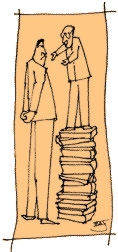|
|
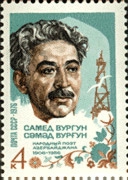 |
 |
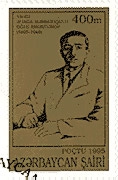 |
Left: Samad Vurghun.
Center: Fuzuli.
Right: Aliagha Vahid.
But there are other complexities as well, including a major shift in language usage, transition to a new alphabet and changes in readers' interests. Now with independence, there is a gradual shift away from Russian - subtle, but at the same time, perceptible. It's probably accurate to say that the direction has finally been set, favoring Azeri to become the "prestige language" in Azerbaijan.
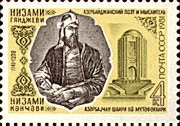 |
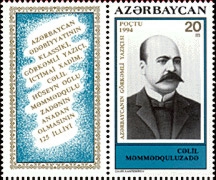 |
Stamps featuring Azerbaijani Writers
Left: Nizami.
Right: Mammadgulizade.
Officially replacing Cyrillic with a modified Latin alphabet has further complicated the literary effort. Typewriters don't exist with all the new alphabet letters, and computers with their interchangeable fonts are not in widespread use. Consequently, since so little has been published in the new alphabet, very few Azerbaijanis are completely comfortable with reading it. This in turn, makes publishers hesitate to invest in publishing the new script, so it becomes a vicious cycle, yet to be broken. Not so long ago, I was browsing in a bookstore in Baku looking for new books published in the Latin script (they're still quite rare except for small works for children).
One finally caught my eye. I pulled it from the shelf, opened it and was surprised to find all Cyrillic text inside. The shopkeeper explained, "We're in transition. Maybe next time, the text can also be printed in Latin. This time, they just did a new cover." Alphabet transitions aren't new to Azerbaijanis. This is the fourth time this century that the alphabet has been officially changed: first, from Arabic script to Latin (1929) then to Cyrillic (1939) and now back again to a slightly different version of Latin (1991). (See AI's entire issue, "Alphabet Transition", September 1993, Vol 1:3).
Azerbaijani Themes
The dominate theme of Azerbaijani literature has always been humanism. Writers mention it quite often: "How can man remain human (meaning honorable), in his relations with others when so many possibilities exist for corruption and self-serving gratification and gain?" But a new stage is being set in Azerbaijan on which to explore man's inhumanity. The new literature is in search of a new identity shaped by its own local indigenous characteristics and life experiences.
Now Azerbaijanis are beginning to write about their own sufferings in the context of their own history - not the Soviet interpretation of it. This includes historical novels, short stories and poetry describing the Soviet takeover in the 1920s, the Soviet army attack on Baku on January 20, 1990, the war with Armenians over Karabakh, and the subsequent dislocation of one million refugees. Today is clearly a period of introspection and re-evaluation of works written during the Soviet period. Fortunately, Azerbaijanis are not dumping writers simply because they happened to have lived during that era; except for when a specific writer produced only propaganda that served the state.
Emphasis in schools used to
be on Russian writers. More and more, Azerbaijanis are studying
native writers. Works are being re-read and re-evaluated for
their artistic merits, not political ideology. New categories,
never before imaginable, are being examined. "Repression
in Literature" explores the works of Azerbaijani writers
who were killed or exiled during the Soviet period such as Almas
Yildirim, Mikhayil Mushfig, Mammad
Amin Rasulzade, Ahmad Javad, Hussein
Javid and others. "Emigration Literature" examines
the works of those who fled the country before or shortly after
the Soviet takeover. "Literature of Southern Azerbaijan"
introduces Azerbaijani writers in Iran, such as the great poet,
Shahriyar. (See AI 1:3, 28. September 93).
A new literature is beginning to emerge in Azerbaijan though
it's still embryonic in form. But the process needs support from
the international community if it is to flourish. Azerbaijan
needs "Patrons of the Literary Arts" just as they've
needed "Patrons of the Performing and Graphics Arts."
Three avenues should be supported: the printing of Azerbaijani
writers into Azeri, as well as the publication of translations
both to and from Azeri. So few works have yet been translated
into foreign languages, with the possible exception of Russian
and Persian. This is where Azerbaijanis living abroad can contribute
greatly by identifying and translating works into the languages
of the respective countries in which they are living. It will
be a great day for Azerbaijani writers, for Azerbaijan as a nation,
and for humanity as a whole, when deserving works from contemporary
Azerbaijani pens are also included in the volumes that make up
the world's greatest and most cherished collection of literary
works. And why shouldn't such a day not come?!
From Azerbaijan International
(4.1)
Spring 1996.
© Azerbaijan International 1996. All rights reserved.
Back to Index
AI 4.1 (Spring 1996)
AI Home | Magazine
Choice
| Topics
| Store
| Contact
us


